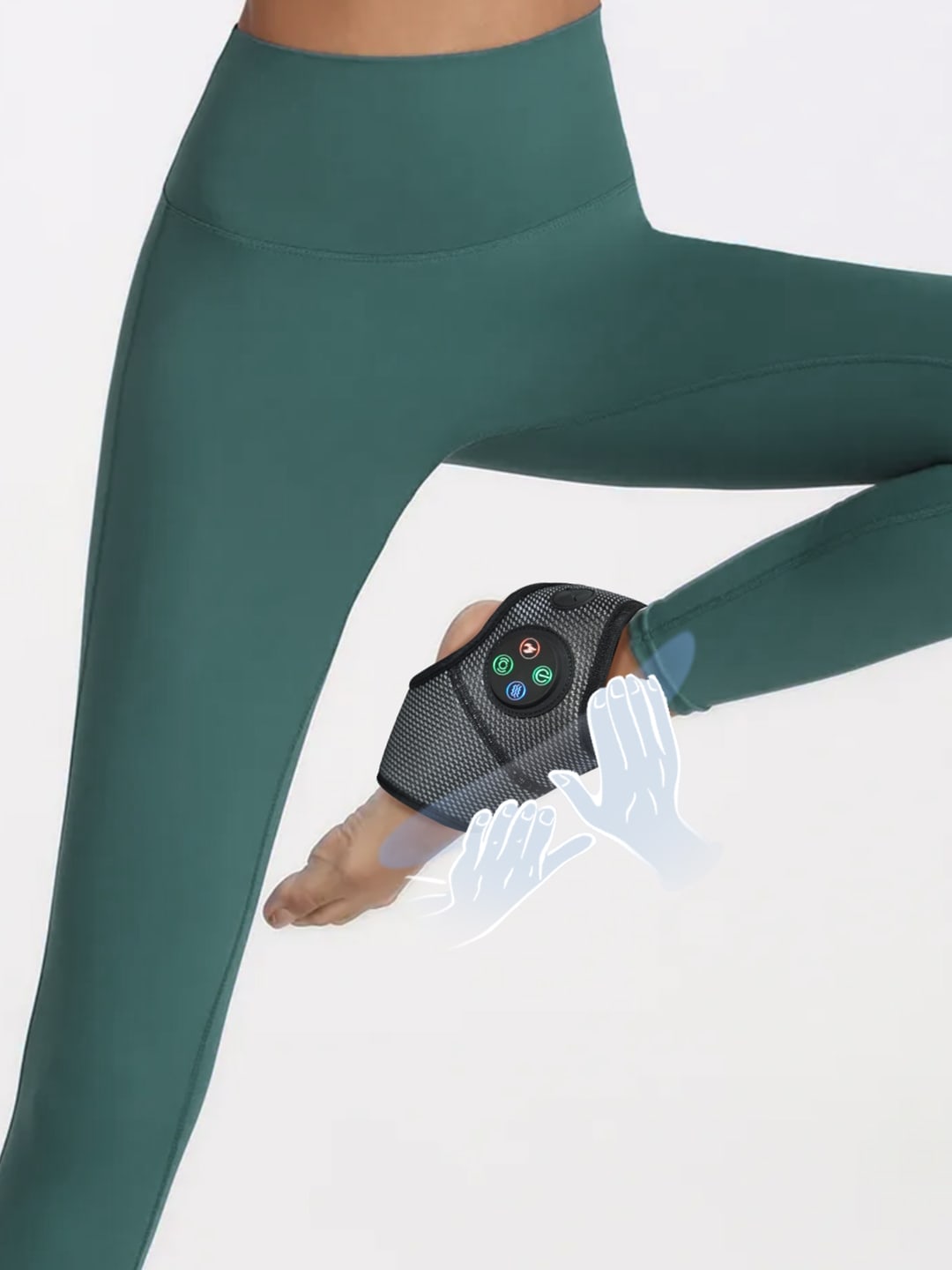Can an Air Compression Foot Massager Soothe Your Aching Post-Workout Feet?
- By Tony
- Updated on
Every day, our feet are the unsung heroes, bearing the brunt of our busy lives, from long hours on our feet to intense workouts. For us fitness enthusiasts, tired, aching feet are a familiar foe after a grueling session. The promise of immediate relief often leads us to seek out solutions, and one device that's been humming its way into many homes is the air compression foot massager. But here's the burning question: is it a true therapeutic breakthrough, offering profound benefits akin to professional physical therapy, or is it just an unproven, self-satisfying device designed for a gentle hum and a fleeting moment of comfort? Let's dive in and unpack its real potential from the perspective of someone who lives and breathes recovery.
Understanding Foot Pain and Recovery Needs
Think about it: your feet are like the foundation of a skyscraper. If that foundation is constantly under stress, experiencing anything from general soreness to more specific issues like the nagging discomfort of neuropathy, the whole structure suffers. After a killer run or a tough training session, muscle fatigue sets in, often accompanied by stiffness and even minor swelling. The desire for quick, effective relief isn't just about comfort; it’s about getting back to peak performance, pronto.
Physiologically speaking, foot discomfort often stems from restricted blood flow, accumulated metabolic waste products, and persistent muscle tension. When our feet are constantly active, circulation can become sluggish, hindering the efficient delivery of oxygen and nutrients while impeding the removal of lactic acid and other toxins. This stagnation can lead to a feeling of heaviness and pain, making effective recovery feel like an uphill battle. It’s a vicious cycle that, if left unaddressed, can impact your entire routine.
- Plantar Fasciitis: Inflammation of the tissue running along the bottom of the foot.
- Achilles Tendinitis: Pain and inflammation of the Achilles tendon.
- General Muscle Soreness: A common post-exercise complaint.
- Swelling/Edema: Fluid retention, often after prolonged activity or standing.

How Air compression Foot Massagers Work
So, how exactly does an air compression foot massager work its magic? At its core, this device employs pneumatic compression technology. Inflatable cuffs within the massager cycle through inflation and deflation, applying rhythmic, gentle pressure to your feet and sometimes your calves. This mimics the pumping action of manual massage, stimulating circulation in a way that feels incredibly soothing, almost like a professional's hands. It's really, really intuitive to set up, which is something many users, myself included, truly appreciate.
This rhythmic compression isn't just for comfort; it has tangible physiological benefits. By gently squeezing and releasing, the massager helps to improve venous return, pushing deoxygenated blood back towards your heart more efficiently. Simultaneously, it aids lymphatic drainage, reducing the buildup of interstitial fluid that contributes to swelling and that heavy, uncomfortable feeling. This enhanced circulation and lymphatic flow contribute directly to muscle relaxation, helping to alleviate tension and promote a sense of overall well-being. It’s a sophisticated process that supports your body’s natural recovery mechanisms.
- Pneumatic Compression Cycles: Controlled inflation and deflation.
- Improved Venous Return: Boosts blood flow back to the heart.
- Enhanced Lymphatic Flow: Reduces fluid retention and swelling.
- Muscle Relaxation and Warmth: Alleviates tension and promotes comfort.
The Benefits of Air Compression for Active Lifestyles
For us who are serious about our fitness goals, the benefits of an air compression foot massager extend far beyond just a pleasant sensation. This device can significantly aid in post-workout recovery by helping to flush out metabolic waste products that accumulate in muscle tissue, effectively reducing Delayed Onset Muscle Soreness (DOMS). Many users report experiencing immediate relief of foot pain and a faster bounce-back, allowing them to tackle their next session with renewed vigor. It’s about optimizing your body’s natural healing process.
Beyond general recovery, these massagers can also be remarkably beneficial for specific concerns. While not a cure, the gentle compression can offer considerable comfort for mild cases of edema, helping to reduce fluid buildup and the associated discomfort. Similarly, for individuals experiencing symptoms of neuropathy, the soothing massage can provide temporary relief from tingling, numbness, and pain, significantly improving comfort. The convenience of having such a device at home, available whenever needed, is a game-changer for those with demanding schedules, allowing for consistent self-care without the need for frequent clinic visits.
- Accelerated Muscle Recovery: Reduces soreness and fatigue.
- Reduction in Swelling and Discomfort: Aids fluid mobilization.
- Temporary Relief for Neuropathic Symptoms: Offers soothing comfort.
- Enhanced Flexibility and Range of Motion: Promotes supple tissues.
- Overall Stress Reduction and Relaxation: A calming experience after a long day.
Choosing and Using Your Compression Foot Massager Safely
When it comes to choosing an air compression foot massager, the market offers a dizzying array of options. You'll find models with various features like adjustable heat, multiple intensity settings, and different massage programs. My advice? Don't just pick the flashiest one. Instead, look for reliable foot massage machine reviews that discuss durability and actual user experience, not just marketing hype. Be wary of exaggerated claims of instant cures; a massager is a supportive tool, not a magic wand, which addresses some skeptical consumer viewpoints. Focus on what truly suits your needs and budget.
Once you have your device, using it effectively is key to maximizing its benefits. I typically recommend starting with a lower intensity setting for 15-20 minutes, gradually increasing as your body adapts. Consistency is paramount—making it a part of your daily recovery ritual can yield impressive results. While it offers excellent relief, remember it complements, rather than replaces, professional physical therapy. For instance, if you’re using an ankle wrap for stability, the massager can still provide a soothing experience around it, but it's not a direct therapeutic intervention for severe issues. Always listen to your body and adjust accordingly.
- Start with Lower Intensity: Allows your body to adapt comfortably.
- Consistency is Key (15-20 minutes daily): Regular use yields better results.
- Combine with Stretching and Hydration: Enhances overall recovery.
- Listen to Your Body's Signals: Adjust settings based on comfort and need.

Recognizing Limitations and Seeking Expert Advice
While the air compression foot massager is an incredibly valuable tool for recovery and relaxation, it's crucial to understand its limitations. It's an excellent aid for managing everyday aches, pains, and post-exercise recovery, but it is unequivocally not a substitute for professional medical diagnosis or treatment. If you’re experiencing persistent, severe pain, unexplained swelling, or worsening symptoms, especially for conditions like severe neuropathy, you absolutely must consult a doctor or a qualified physical therapist. They can provide an accurate diagnosis and a comprehensive treatment plan that might include more targeted interventions.
Think of it this way: a massager can help you recover and feel better, but it can't fix a broken bone or treat a deep-seated medical condition. For complex issues, a medical professional might prescribe specific exercises, specialized therapies, or even suggest devices like a medical-grade compression bandage for foot support, which are tailored to your specific condition and offer a different level of therapeutic intervention than a consumer massager. Understanding when to seek expert help ensures you receive the most appropriate and effective care for your health concerns.
- Sudden, Severe Pain: Could indicate a serious underlying issue.
- Unexplained Bruising or Discoloration: Requires immediate medical attention.
- Persistent Swelling Not Relieved by Rest: May signal a circulatory or other medical problem.
- Numbness or Tingling Worsening: A sign to consult a neurologist or doctor.
- Fever Accompanying Foot Pain: Could indicate an infection.
So, is the air compression foot massager a revolutionary therapeutic breakthrough? To be honest, it's more nuanced than a simple yes or no. While it doesn't replace a doctor or dedicated physical therapy, it absolutely delivers on its promise of accessible relief and enhanced recovery. For me, as your portable recovery expert, I see its immense value as a complementary tool in any fitness enthusiast's regimen. It’s convenient, effective for daily aches, and a fantastic aid for flushing out post-workout fatigue.
In essence, this device acts as a highly effective, self-satisfying method for managing discomfort and promoting well-being at home. It’s a powerful ally in your quest for consistent recovery, helping to alleviate foot pain, improve circulation, and relax tired muscles. Incorporate it wisely, listen to your body, and you'll find that this gentle hum can indeed be a revolutionary part of your personal relief and recovery journey. It’s an investment in your comfort and long-term activity, making it a valuable addition to your self-care arsenal.
Frequently Asked Questions About Compression Foot Massagers
What is compression foot massager?
A compression foot massager is an electronic device designed to apply rhythmic pressure to your feet using inflatable air bladders. These bladders inflate and deflate in cycles, mimicking the effects of a manual massage to promote blood circulation, reduce swelling, and relax muscles. It's essentially a pneumatic massage system for your lower extremities.
How does it help circulation?
The rhythmic inflation and deflation of the air bladders in a compression foot massager create a pumping action. This action helps to push deoxygenated blood and lymphatic fluid back towards the core of your body, improving venous return and lymphatic drainage. This enhanced flow ensures more efficient delivery of oxygen and nutrients to tissues and better removal of metabolic waste products, thereby boosting overall circulation in the feet and lower legs.
Is it good for edema?
Yes, a compression foot massager can be beneficial for mild to moderate cases of edema (swelling) in the feet and ankles. The pneumatic compression helps to gently push accumulated fluid out of the affected areas and back into the circulatory and lymphatic systems. This can significantly reduce discomfort and the appearance of swelling. However, for severe or persistent edema, it's crucial to consult a healthcare professional to rule out underlying medical conditions.




